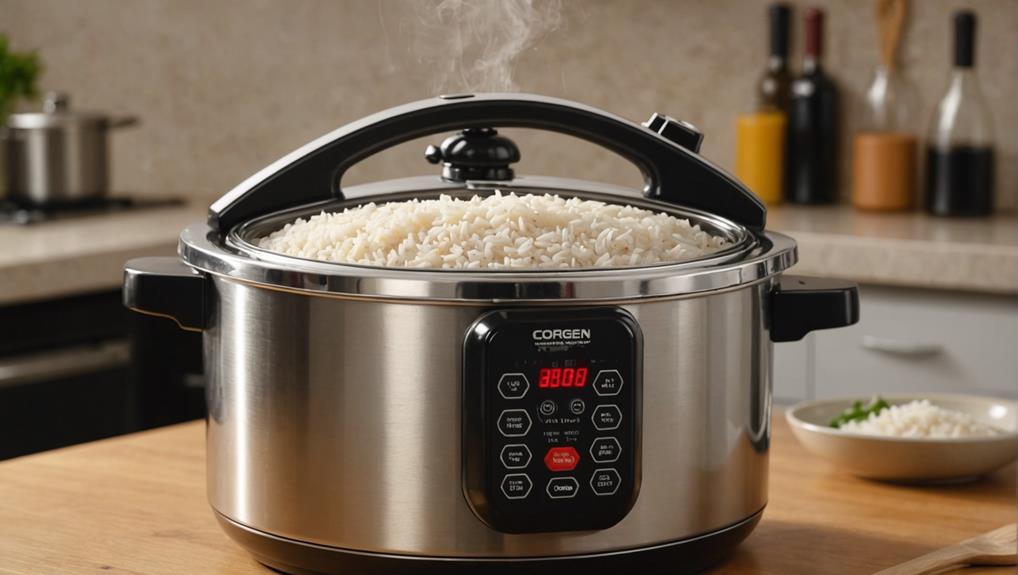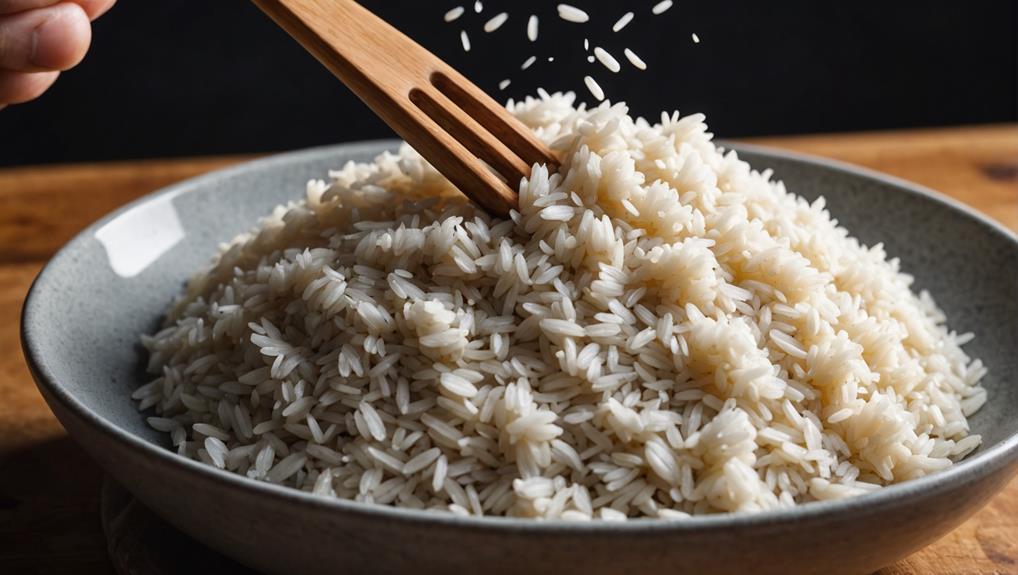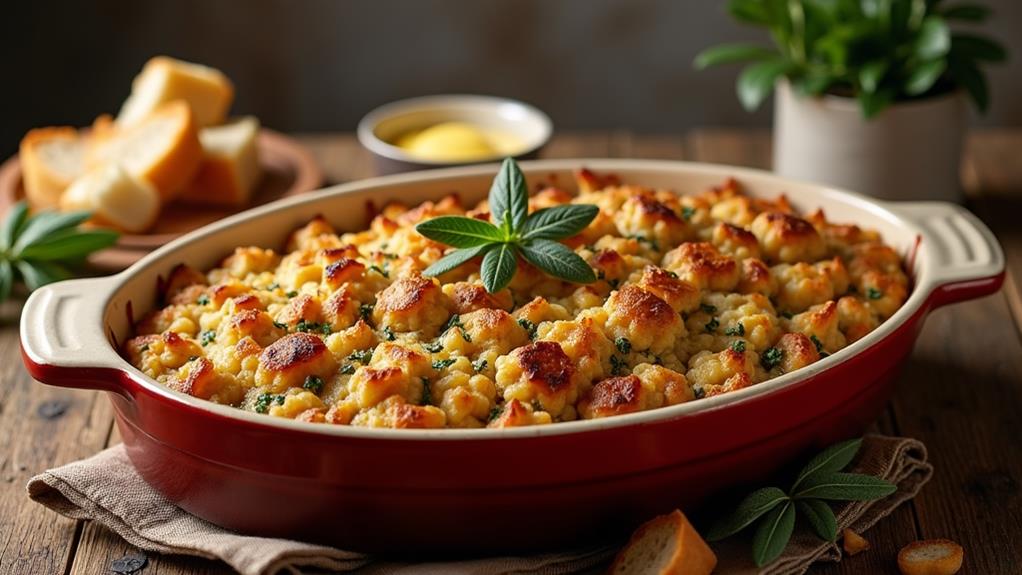To achieve flawless rice in your pressure cooker, start by rinsing the rice until the water runs clear. Use the correct rice-to-water ratio: 1:3/4 for white rice, 1:1.25 for brown rice, and 1:1.5 for wild rice. Set your cooker to manual HIGH pressure, cooking white rice for 4 minutes and brown rice for 12 minutes. After cooking, allow a 10-minute natural release for optimal texture. Gently fluff the rice with a fork and serve immediately. For added flavor, consider using broth instead of water or adding herbs and spices. These simple steps will consistently produce perfect rice, but there's more to explore in perfecting your technique.
Preparing Your Pressure Cooker
Five key steps will ensure your pressure cooker is primed for perfect rice.
First, select a pressure cooker that's at least 4 liters in size for effective rice cooking, with 6 liters or larger being ideal if you plan on steaming.
Next, thoroughly rinse the rice under cold water until it runs clear, removing excess starch to enhance flavor.
Third, master the rice-to-water ratio specific to your rice type; for instance, brown rice requires 1.25 cups of water per cup of rice.
Fourth, avoid overfilling your cooker by ensuring the rice and liquid combined don't exceed half its capacity.
Measuring Rice and Water
To achieve flawless rice in your pressure cooker, you'll need to master the art of measuring rice and water accurately.
Start by understanding the perfect rice-to-water ratios for different rice types, such as 1:3/4 for white rice and 1:1 1/4 for brown rice, and use precise measuring tools to ensure consistency.
As you adjust for various rice types, remember that proper measurement is key, with 1 cup of uncooked rice typically yielding 3 cups when cooked, serving about 8 people comfortably.
Perfect Rice-To-Water Ratios
Achieving perfectly cooked rice in a pressure cooker starts with nailing the right rice-to-water ratio. You'll need to adjust this ratio based on the type of rice you're cooking. For white rice, including basmati and jasmine varieties, you'll want to use ¾ cup of water for every cup of rice.
Regular white rice, however, requires a 1:1 ratio. If you're pressure cooking brown rice, increase the water to 1¼ cups per cup of rice to accommodate its longer cooking time and higher absorption rate. Wild rice demands even more water, with 1½ cups per cup of rice.
Before you start measuring, don't forget to rinse your rice until the water runs clear. This crucial step removes excess starch, ensuring your cooked rice has the ideal texture and flavor.
Measuring Tools and Techniques
Accurate measurement is the cornerstone of perfect pressure-cooked rice. To achieve fluffier rice in your pressure cooker, start by rinsing the rice thoroughly in a fine mesh strainer until the water runs clear, removing excess starch.
Next, employ a standard measuring cup for precise control over your cooking ratios. For brown rice, use 1 cup of rice to 1.25 cups of water, while basmati or jasmine rice requires about 1 cup of rice to 0.75 cups of water. Always measure rice and water separately to maintain accuracy.
For optimal results, consider using a liquid measuring cup for water to account for surface tension differences. This approach ensures more precise measurements compared to dry measuring cups.
Remember to adjust your measuring quantities based on the rice type you're using, as each variety has unique water requirements. For instance, wild rice typically needs 1.5 cups of water per cup of rice.
Adjusting for Rice Types
Mastering the art of pressure-cooked rice requires more than just precise measurements. You'll need to adjust your rice-to-water ratio based on the type of rice you're cooking. For white rice, stick to a 1:1 ratio in your pressure cooker. However, when you're working with Basmati or Jasmine rice, increase the water slightly to 1:1.25 for optimal texture.
To cook brown rice perfectly, use a 1:1.25 ratio and extend the cooking time to 15-20 minutes at high pressure. Wild rice demands even more water, with a 1:1.5 ratio and 25 minutes of cooking time. Don't forget to rinse your rice until the water runs clear, especially for white and fragrant varieties. This step removes excess starch, preventing sticky rice and ensuring a fluffy texture.
For culinary innovators, experiment with different ratios to enhance flavor and texture. Try combining rice types for unique dining experiences.
Cooking Process Essentials

When it comes to cooking perfect rice in your pressure cooker, mastering two key elements will elevate your results: precise timing and accurate water-to-rice ratios.
You'll want to set your cooker to the manual HIGH pressure setting, allowing 4 minutes for white rice and 12 minutes for brown rice, followed by a crucial 10-minute natural pressure release.
For ideal texture, remember that different rice types require specific ratios: use 1:1 for white rice, 1:1.25 for brown rice, and 1:2 for wild rice, adjusting as needed based on your particular variety.
Precise Timing Matters
To achieve perfect rice in a pressure cooker, precise timing is paramount.
Your Instant Pot's manual setting is your secret weapon for mastering various rice types. For fluffy white rice, set the cooker to high pressure for 4 minutes, followed by a 10-minute natural release.
Brown rice requires a longer cook time of 12 minutes at high pressure, also with a 10-minute natural release.
Wild rice demands even more patience, needing 15 minutes of high-pressure cooking and the same natural release period.
Mastering Water-Rice Ratios
One of the most crucial aspects of cooking perfect rice in a pressure cooker is getting the water-to-rice ratio just right. For cooking white rice, you'll want to use a 1:1 ratio, meaning one cup of water for every cup of uncooked rice. This ensures even cooking without excessive stickiness.
If you're preparing Basmati or Jasmine rice, adjust the ratio to 1 cup of rice to ¾ cup of water for that perfect fluffed texture.
Brown rice requires a different approach. Use 1¼ cups of water for each cup of rice, and expect a longer cooking time of 20-25 minutes at high pressure.
For wild rice, increase the water to 1½ cups per cup of rice, with a cooking time of about 25 minutes at high pressure to achieve optimal tenderness.
Before you begin, don't forget to rinse your rice under cold water until it runs clear. This removes excess starch, which can significantly impact the final texture of your rice.
Mastering the Natural Release
In light of achieving perfectly cooked rice, mastering the natural release method is crucial. When using your pressure cooker, this innovative technique allows the pressure to decrease gradually on its own, enhancing the rice's texture and ensuring even cooking. For optimal results, let the cooker naturally release pressure for at least 10 minutes after the cooking cycle ends.
During natural release, residual heat continues to cook the rice, resulting in fluffier and less sticky grains. This method is particularly effective for starchy varieties like Jasmine and Basmati, helping you achieve tender, separate grains.
If you're short on time, waiting 5-7 minutes before quick release can help reduce stickiness, but natural release remains the gold standard for perfect rice.
To master this technique, simply resist the urge to open your pressure cooker immediately after the cycle ends. Instead, allow the appliance to work its magic as the pressure gradually dissipates.
This patience will reward you with rice that's not only perfectly cooked but also boasts an improved texture and consistency. By incorporating natural release into your rice-cooking routine, you'll elevate your culinary skills and consistently produce restaurant-quality results.
Fluffing and Serving Techniques

After mastering the perfect cook and release, fluffing and serving your rice correctly is the final step to elevate your dish. Gently fluffing with a fork separates the grains, preventing clumping and enhancing texture.
To further refine your rice, consider adding a tablespoon of butter or a drizzle of olive oil, which not only boosts flavor but also reduces stickiness.
For optimal results, serve your rice immediately after fluffing. This ensures the best texture and prevents it from drying out. Innovate your rice dishes by experimenting with herbs or spices during the fluffing process, tailoring the flavors to complement your main course.
When dealing with leftovers, follow these steps:
- Allow rice to cool completely
- Transfer to an airtight container
- Store in the refrigerator for up to 5 days
When reheating, add a splash of water to maintain moisture. This technique preserves the rice's quality, ensuring a delightful dining experience even with leftovers.
Variations and Customizations
Now that you've mastered the basics, it's time to explore the exciting world of rice variations and customizations. Your Instant Pot is the perfect tool for experimenting with different rice varieties, each requiring unique water ratios and cooking times.
Try Jasmine, Basmati, or medium-long grain rice to discover new flavors and textures.
To elevate your rice game, swap water for chicken or vegetable broth, and add herbs and spices during cooking. This simple change will infuse your rice with rich, complex flavors.
For improved texture, add a tablespoon of avocado or olive oil to prevent sticking and retain moisture. Want fluffier rice? A teaspoon of white vinegar in the cooking water can work wonders.
Customize your results by adjusting cooking times and pressure release methods. For brown rice, a longer natural release is key to achieving the perfect consistency.
Don't be afraid to experiment with these variables to find your ideal combination. With these tips, you'll transform your Instant Pot into a rice customization powerhouse, creating dishes tailored to your exact preferences and culinary vision.
Frequently Asked Questions
What Is the Secret to Fluffy Rice in a Rice Cooker?
To achieve fluffy rice texture, rinse grains, use correct cooking ratios, and let pressure release naturally. Enhance flavor with vinegar or oil. Experiment with different grain varieties and water temperatures. Don't forget to fluff before serving!
What Is the Secret to Cooking Rice?
Fluffy yet firm, your perfect rice awaits. Master water ratios for various rice types, rinse thoroughly, and experiment with cooking methods. Enhance flavor with stock or vinegar, and let it rest. Avoid common mistakes for nutritious, versatile dishes.
How Do I Get the Best Results From a Rice Cooker?
You'll get the best results by rinsing your rice, using the right water ratio for different rice types, and adjusting pressure settings. Don't forget to experiment with soaking, cooking times, and ingredient pairings for diverse textures and flavored rice.
Why Does My Pressure Cooker Rice Come Out Mushy?
You're likely using too much water or overcooking. Adjust your water ratio, fine-tune cooking times, and select the right rice variety. Try soaking, proper pressure cooking, natural steam release, and post-cooking fluffing for innovative, perfectly textured results.
Final Thoughts
You've now mastered the art of perfect pressure cooker rice, yet ironically, you'll find yourself craving the challenge of stovetop cooking. Don't be surprised if you start eyeing that neglected saucepan with newfound interest. But let's face it, you're not going back. Your pressure cooker has become your culinary confidant, transforming a once-daunting task into a foolproof ritual. Embrace this effortless method, and you'll never again stress over mushy or burnt rice. It's time to savor your perfectly cooked grains.















